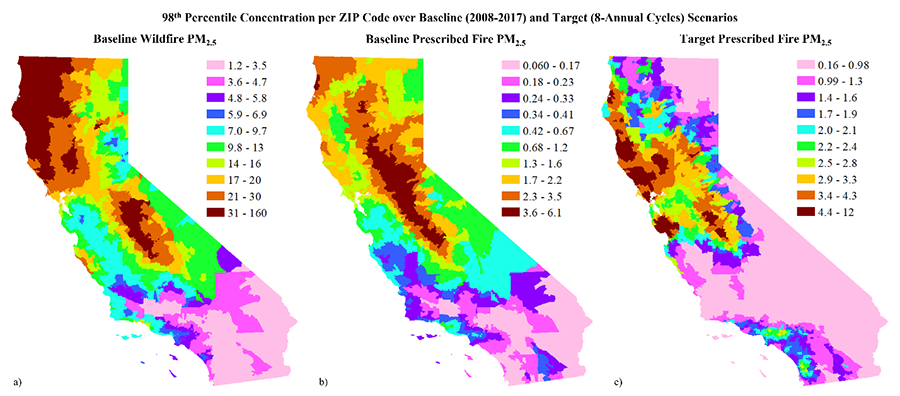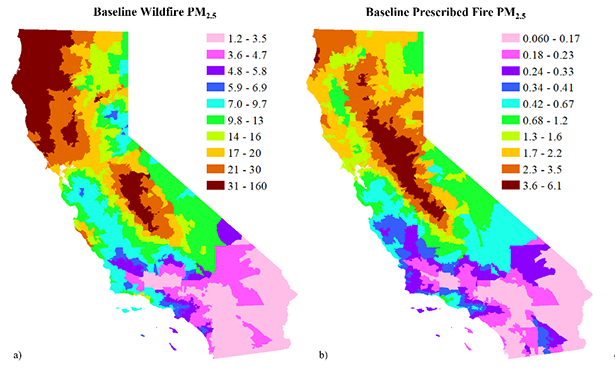Journal Article: Projected Smoke Impacts from Increased Prescribed Fire Activity in California's High Wildfire Risk Landscape
Clients
California Department of Public Health
California Department of Forestry and Fire Protection (CAL FIRE)
Sequoia Foundation
As severe wildfires have increased in frequency and intensity in California over the last decade, the use of prescribed fires will be increased to help manage forest fuels and reduce the risks of wildfires. To better understand the health impacts from both wildfire and prescribed fire smoke, Sonoma Technology scientists modeled air quality impacts from past wildfires and prescribed fires and estimated how air quality may be affected in the future if the use of prescribed fires were to double. This study found that air quality is impacted significantly more from wildfires than prescribed fires for the majority of California regions. The findings have important implications since <a href="https://public.wmo.int/en/media/news/number-of-wildfires-forecast-rise-50-2100" target="_blank">wildfires are forecasted to increase due to climate change</a href>, and prescribed burns are a key management strategy to help reduce fire-related risks.<br>
The results of this study were published in the journal <a href="https://www.sciencedirect.com/science/article/pii/S1352231023004193?via%3Dihub" target="_blank">Atmospheric Environment.</a href> The full abstract of the article is below.<br>
California has experienced multiple catastrophic wildfires over the last decade, fostering the need for increased forest management and understanding of the health impacts of wildfire and prescribed fire smoke. We calculated air quality impacts from past wildfires and prescribed fires and estimated how air quality may be affected under a future scenario in which prescribed fire is proposed to more than double. We merged satellite and agency records to establish a 10-year (2008–2017) baseline wildfire and prescribed fire inventory for California. Daily emissions and dispersion modeling were used to evaluate relative contributions from wildfire and prescribed fire. We scaled up prescribed burns to reach the >200,000 ha per year target, modeled over eight cycles (years) to encompass 1.6 million hectare of California Department of Forestry and Fire Prevention Priority Landscapes 4&5. We found that baseline wildfire contributes up to 20x more smoke PM<sub>2.5</sub> concentrations than baseline prescribed fire. Target prescribed fire scenario smoke concentrations are anticipated to be ∼3x that of baseline prescribed fire. Baseline and target prescribed fire scenarios do not contribute sufficient PM<sub>2.5</sub> to exceed air quality standards from smoke alone at the community (ZIP code) level. Baseline wildfires contribute enough PM<sub>2.5</sub> to cause unhealthy air quality, even without contributions from ambient background PM<sub>2.5</sub>. The target prescribed fire scenario only exceeds the baseline smoke from wildfire and prescribed fire in 4% of California ZIP codes. Overall, we found that air quality is impacted significantly more from wildfires than prescribed fires, past and proposed, for the majority of California.
The results of this study were published in the journal <a href="https://www.sciencedirect.com/science/article/pii/S1352231023004193?via%3Dihub" target="_blank">Atmospheric Environment.</a href> The full abstract of the article is below.<br>
California has experienced multiple catastrophic wildfires over the last decade, fostering the need for increased forest management and understanding of the health impacts of wildfire and prescribed fire smoke. We calculated air quality impacts from past wildfires and prescribed fires and estimated how air quality may be affected under a future scenario in which prescribed fire is proposed to more than double. We merged satellite and agency records to establish a 10-year (2008–2017) baseline wildfire and prescribed fire inventory for California. Daily emissions and dispersion modeling were used to evaluate relative contributions from wildfire and prescribed fire. We scaled up prescribed burns to reach the >200,000 ha per year target, modeled over eight cycles (years) to encompass 1.6 million hectare of California Department of Forestry and Fire Prevention Priority Landscapes 4&5. We found that baseline wildfire contributes up to 20x more smoke PM<sub>2.5</sub> concentrations than baseline prescribed fire. Target prescribed fire scenario smoke concentrations are anticipated to be ∼3x that of baseline prescribed fire. Baseline and target prescribed fire scenarios do not contribute sufficient PM<sub>2.5</sub> to exceed air quality standards from smoke alone at the community (ZIP code) level. Baseline wildfires contribute enough PM<sub>2.5</sub> to cause unhealthy air quality, even without contributions from ambient background PM<sub>2.5</sub>. The target prescribed fire scenario only exceeds the baseline smoke from wildfire and prescribed fire in 4% of California ZIP codes. Overall, we found that air quality is impacted significantly more from wildfires than prescribed fires, past and proposed, for the majority of California.
Air Quality
Applied Research
Climate
Data Visualization
Emissions
Exposure
Fire and Smoke
Health
Modeling
Policy and Planning


Samantha J. Kramer

Samantha
J
Kramer
Manager, Wildland Fire and Smoke Program
skramer@sonomatech.com
/sites/default/files/2023-03/SJKres.pdf
